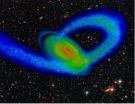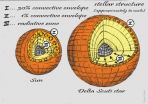(Press-News.org) Raised yellow patches of skin (xanthelasmata) around the upper or lower eyelids are markers of an individual's increased risk of having a heart attack or suffering from heart disease, finds research published on bmj.com today.
The study, led by Professor Anne Tybjærg-Hansen at the University of Copenhagen, also concludes that white or grey rings around the cornea (arcus corneae) are not linked to an increased risk.
Previous research has established that both xanthelasmata and arcus corneae are deposits of cholesterol. However, around half of the individuals who have either or both condition will not test positively for high cholesterol in a blood test.
The researchers wanted to investigate links between xanthelasmata and/or arcus corneae and an increased risk of heart attack, heart disease, stroke, severe thickening of the arteries or premature death in the general population, as the evidence in this area is lacking.
Indeed, many patients are referred to dermatologists so that xanthelasmata can be removed, they add.
They surveyed 12,745 individuals who had participated in the Copenhagen City Heart Study. The participants were aged between 20 and 93 and were free of heart disease when the study began. They were followed from 1976-8 until May 2009 with 100% complete follow-up.
At the beginning of the study 563 (4.4%) of participants had xanthelasmata and 3,159 (24.8%) had arcus corneae.
During the follow-up 1,872 of the participants had a heart attack, 3,699 developed heart disease, 1,498 had a stroke, 1,815 developed cerebrovascular disease and 8,507 died.
The results show that in all age groups for both men and women, the risk of having a heart attack, developing heart disease or dying within a ten year period increased in individuals with xanthelasmata. This increased risk is independent of other well-known risk factors such as gender, smoking, obesity or high blood pressure and cholesterol levels.
The highest risks were found in men between the ages of 70 and 79. Those with xanthelasmata had a 53% increased risk compared to the 41% risk for men without the condition - an absolute increase of 12%. The corresponding figures for women were 35% and 27%.
In contrast, the results show that arcus corneae is not a significant independent risk predictor for heart attack or heart disease.
The authors conclude that the presence of xanthelasmata could help clinicians when they diagnose heart disease and associated conditions. And they add that their findings "could be of particular value in societies where access to laboratory facilities and thus lipid profile measurement is difficult."
An accompanying editorial concludes that, overall, the evidence highlights the importance of a comprehensive physical examination and suggests that xanthelasmata could be used by general clinicians to help identify people at higher risk of cardiovascular disease.
### END
Yellow patches around eyelids predict risk of heart problems
Research: Xanthelasmata, arcus corneae, and ischaemic vascular disease and death in general population: prospective cohort study
2011-09-16
ELSE PRESS RELEASES FROM THIS DATE:
Seaside fortress was a final stronghold of early Islamic power
2011-09-16
Archaeologists have long known that Yavneh-Yam, an archaeological site between the Israeli cities of Tel Aviv and Ashdod on the Mediterranean coast, was a functioning harbor from the second millennium B.C. until the Middle Ages. Now Tel Aviv University researchers have uncovered evidence to suggest that the site was one of the final strongholds of Early Islamic power in the region.
According to Prof. Moshe Fischer of TAU's Department of Archaeology and Near Eastern Cultures and head of the Yavneh-Yam dig, the recent discovery of a bath house from the Early Islamic period ...
Prasugrel: Indications of an additional benefit for some patients, but also of greater harm
2011-09-16
In order to better prevent blood clots, the drugs clopidogrel or prasugrel can be prescribed to patients with acute ischaemia of the heart muscle, in addition to acetylsalicylic acid (ASA). The German Institute for Quality and Efficiency in Health Care (IQWiG) has now investigated whether, in patients whose vessels were dilated by a percutaneous coronary intervention (PCI), the combination of prasugrel plus ASA has a higher patient-relevant benefit than ASA alone, or than combination therapy with clopidogrel plus ASA. The findings of the assessment provide indications that ...
Mobile phone electromagnetic field affects local glucose metabolism in the human brain
2011-09-16
Recent PET-measurements in Turku, Finland, show that the GSM mobile phone electromagnetic field suppresses glucose metabolism in temporoparietal and anterior temporal areas of the hemisphere next to the antenna.
Thirteen young healthy males were exposed to the GSM signal for 33 minutes. The study, initiated by Centre for Cognitive Neuroscience (CCN) at University of Turku, was methodologically unique combining the expertice in brain imaging (National PET-Center and CCN), measurements and modeling of radiation (Radiation and Nuclear Safety Authority in Finland, STUK) ...
Archivist in the sound library
2011-09-16
People are adept at recognizing sensations such as sounds or smells, even when many stimuli appear simultaneously. But how the association works between the current event and memory is still poorly understood. Scientists at the Bernstein Center and the Ludwig-Maximilians Universität (LMU) München have developed a mathematical model that accurately mimics this process with little computational effort and may explain experimental findings that have so far remained unclear. (PLoS ONE, September 14, 2011)
The so-called 'cocktail party-problem' has already kept scientists ...
How the Milky Way got its spiral
2011-09-16
PITTSBURGH—The signature spiral arms of the Milky Way galaxy were likely formed by an epic collision between the Milky Way and the Sagittarius Dwarf galaxy, according to a University of Pittsburgh researcher and his collaborators, published today in the prestigious British journal Nature.
Supercomputer simulations by Christopher W. Purcell, postdoctoral research associate in the Department of Physics and Astronomy in Pitt's School of Arts and Sciences, and colleagues report their findings in a paper titled "The Sagittarius Impact as an Architect of Spirality and Outer ...
Los Angeles Dentist Achieves Exceptional Level of Invisalign Case Experience
2011-09-16
Dr. Shervin Louie, best Los Angeles dentist, has earned the status of Invisalign premier provider. This certificate is only awarded to those dental professionals who have achieved an exceptional level of Invisalign case experience.
Invisalign Preferred Providers have achieved a level of clinical training and experience in treating patients with the Invisalign system. Dentists must maintain regular treatment submission and complete ongoing training classes in order to earn the designation as a Preferred Provider of Invisalign.
"I am honored to be name an Invisalign ...
Restoring forests and planting trees on farms can greatly improve food security
2011-09-16
NAIROBI, KENYA (12 SEPTEMBER 2011) – Restoring and preserving dryland forests and planting more trees to provide food, fodder and fertilizer on small farms are critical steps toward preventing the recurrence of the famine now threatening millions of people in the Horn of Africa, according to forestry experts from the CGIAR Consortium.
Across the Horn, drought-induced famine has claimed tens of thousands of lives and swelled refugee camps in Kenya, Ethiopia and elsewhere, with millions of starving people – many of them children. Bearing the brunt of the crisis is Somalia, ...
The turbulent lives of stars
2011-09-16
This press release is available in German.
The stars are boiling! The reason is the energy generated in the center of the star that wants to escape. If this does not happen quickly enough, the star starts to 'boil' in the outer layers causing vibrations that result in light variations, like in the Sun. Such oscillations have now been discovered by Victoria Antoci and collaborators using the NASA spacecraft Kepler, but in a much hotter star. The scientists publish this in the most recent issue of Nature.
Besides the discovery of earth-like planets, astronomy is concerned ...
Serotonin levels affect the brain's response to anger
2011-09-16
Fluctuations of serotonin levels in the brain, which often occur when someone hasn't eaten or is stressed, affects brain regions that enable people to regulate anger, new research from the University of Cambridge has shown.
Although reduced serotonin levels have previously been implicated in aggression, this is the first study which has shown how this chemical helps regulate behaviour in the brain as well as why some individuals may be more prone to aggression. The research findings were published today, 15 September, in the journal Biological Psychiatry.
For the study, ...
Two-thirds of hepatitis C patients can see a cure in half the time, new study finds
2011-09-16
LOS ANGELES (Sept. 15, 2011) – Treatment with a telaprevir-based combination regimen for hepatitis C – heretofore a chronic, destructive and difficult to manage disease – effectively can be shortened to six months in about two-thirds of patients, finds a new study published Thursday in the New England Journal of Medicine.
Telaprevir, a drug approved for use against hepatitis C in May, inhibits replication of virus. This anti-viral drug and a similar medication called boceprevir have nearly doubled the number of patients with sustained response. Among patients treated ...
LAST 30 PRESS RELEASES:
Sleeping in on weekends may help boost teens’ mental health
Study: Teens use cellphones for an hour a day at school
After more than two years of war, Palestinian children are hungry, denied education and “like the living dead”
The untold story of life with Prader-Willi syndrome - according to the siblings who live it
How the parasite that ‘gave up sex’ found more hosts – and why its victory won’t last
When is it time to jump? The boiling frog problem of AI use in physics education
Twitter data reveals partisan divide in understanding why pollen season's getting worse
AI is quick but risky for updating old software
Revolutionizing biosecurity: new multi-omics framework to transform invasive species management
From ancient herb to modern medicine: new review unveils the multi-targeted healing potential of Borago officinalis
Building a global scientific community: Biological Diversity Journal announces dual recruitment of Editorial Board and Youth Editorial Board members
Microbes that break down antibiotics help protect ecosystems under drug pollution
Smart biochar that remembers pollutants offers a new way to clean water and recycle biomass
Rice genes matter more than domestication in shaping plant microbiomes
Ticking time bomb: Some farmers report as many as 70 tick encounters over a 6-month period
Turning garden and crop waste into plastics
Scientists discover ‘platypus galaxies’ in the early universe
Seeing thyroid cancer in a new light: when AI meets label-free imaging in the operating room
Neutrophil-to-lymphocyte ratio may aid risk stratification in depressive disorder
2026 Seismological Society of America Annual Meeting
AI-powered ECG analysis offers promising path for early detection of chronic obstructive pulmonary disease, says Mount Sinai researchers
GIMM uncovers flaws in lab-grown heart cells and paves the way for improved treatments
Cracking the evolutionary code of sleep
Medications could help the aging brain cope with surgery, memory impairment
Back pain linked to worse sleep years later in men over 65, according to study
CDC urges ‘shared decision-making’ on some childhood vaccines; many unclear about what that means
New research finds that an ‘equal treatment’ approach to economic opportunity advertising can backfire
Researchers create shape-shifting, self-navigating microparticles
Science army mobilizes to map US soil microbiome
Researchers develop new tools to turn grain crops into biosensors
[Press-News.org] Yellow patches around eyelids predict risk of heart problemsResearch: Xanthelasmata, arcus corneae, and ischaemic vascular disease and death in general population: prospective cohort study


